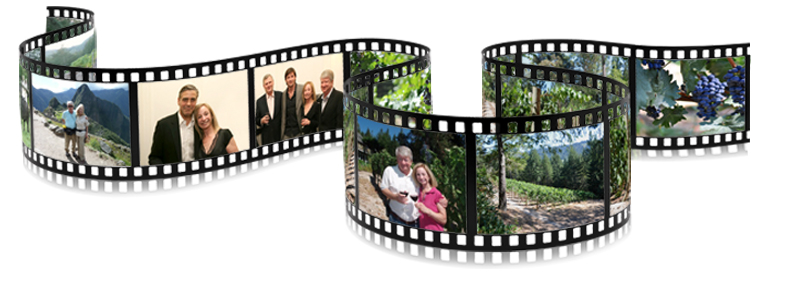
From Hollywood to Vine with Vineyard {511}
Adventures in Wine, Food, Film and Travel
Bordeaux Wine Cruise
The City of Bordeaux was the perfect place to start our Bordeaux wine cruise on the Dordonne and Garrone rivers throughout the region of Bordeaux. But the port City of Bordeaux is not just about the "Bordeaux blend." It's not just about what happens inside that French oak. It's about the old, the history which reflects the legendary land of monumental architecture of the chateaux, and the new; not just the Bordeaux that was a dingy city to pass through with coal-blackenned facades on the way to somewhere else, but now a vibrant and beautiful city in its own right. It was named a UNESCO world heritage site in 2007 after its crumbling city walls had been taken down and the light let in.
We stayed at the Intercontinental Le Grand Hotel, built where the Roman forum once stood, and where we dined at its celebrity chef Gordon Ramsay restaurant. From our hotel window we saw a sparkling street dominated by the opera house with its grand pillars.
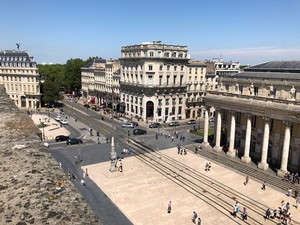
Of course, Bordeaux is about wine too, reflected in its wine museum, La Cite du Vin, designed by Anouk Legendre and Nicalas Desmazieres. Its shimmering gold aluminum facade resembles the swishing around a wine glass.
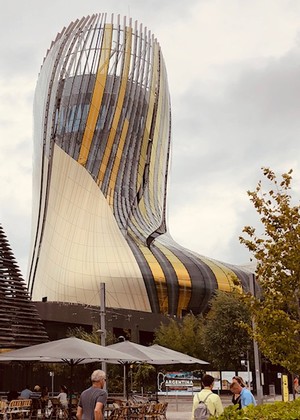
We toured the old city ("Vielle Ville"), in the rain. Apparently, it rains a lot in Bordeaux, just as it does in Paris. In fact, Bordeaux reminded me of a little Paris.
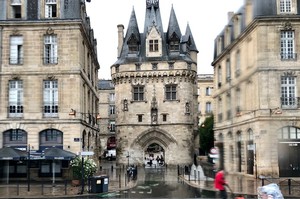
But the main reason Ed and I were in Bordeaux was to particapate in a "wine lover's cruise" aboard the AMADolce,
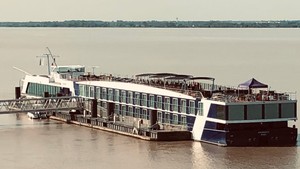
hosted by friends Peter and Katie Mondavi of Napa Valley's historic Charles Krug Winery to explore the greater Bordeaux region.
Aboard ship, Peter gave several tastings and interesting discussions on board about Bordeaux and Charles Krug wines.
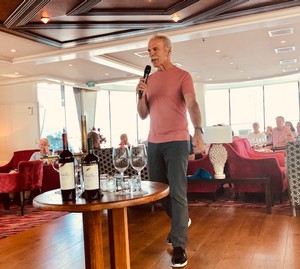
We even had a blind tasting, comparing Krug and Bordeaux. I preferred the Krug. I guess I'm partial to Napa wines.
Our shore exursions were very interesting. One of the first was to Saint-Emilion AOC (appellation d'original controllee, a government controlled designation of origin, which signifies where grapes are grown, similar to our AVA or American Viticulture Area). We drove through some very lush vineyards with views of stately chateaux,
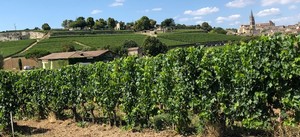
and vistited the historic Chateau Soutard for a Grand Cru Classe wine tasting
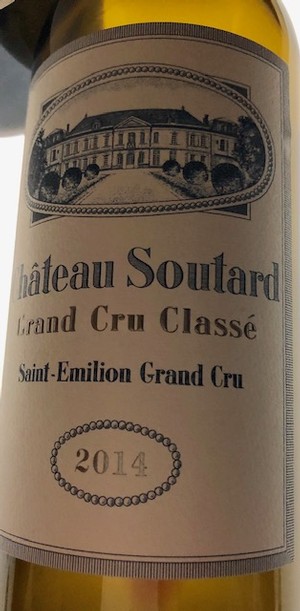
in modern vat and barrel rooms replete with sparkling chandeliers.
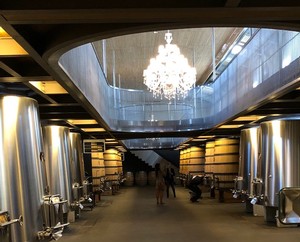
On the way to the Sauternes wine region, we visited the historic Roquetaillarde Castle in Mazeres, a fortress initially built in the 10th century by Charlemagne.
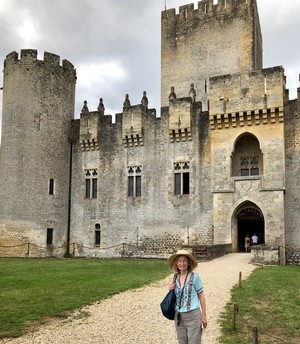
It has been in the same family for 300 years. In fact, the current owner led a tour of the castle and demonstrated how his ancestors could pull up the drawbridge in case of an invasion.
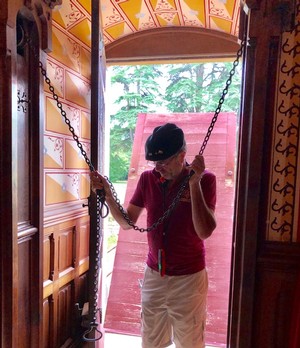
In Bommes, located in the Sauternes wine appelation, we toured Chateau Guiraud to see how its lovely, sweet Sauternes wine was fermented in underground steel tanks.
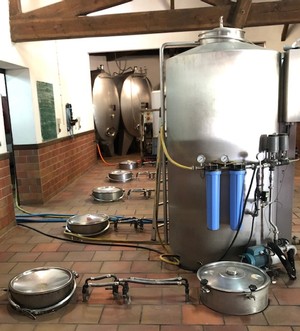
On our last day in Bordeaux, Katie and Peter Mondavi graciously hosted a private winery tour, delicious luncheon and tasting at Chateau Haut-Bages Liberal in the Pauillac appelation. The wine produced there was classified as one of eighteen Cinquiemes Crus in the Bordeaux Wine Official Classification of 1855. It is owned by the Lurton family, involved in Bordeaux wine production since 1820.
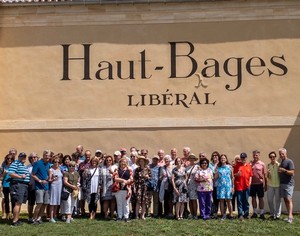
We increased our knowledge of Bordeaux wine and made some new friends on this river cruise; we hope we will meet up with them again soon.
Spain and Portugal Douro River Wine Cruise
The Douro River, in Portugal's stunning Douro Valley, is where Ed and I experienced the most beautiful wine growing regions in the world aboard an AmaWaterways wine cruise, sponsored by The Dry Creek Winegrower's Association. But first, in order to get to the cruise, we had to fly into Spain's capital, Madrid, and stayed there for three nights to enjoy the city and Spanish wine and cuisine.
On our first night there, we at Restaurante Botin (founded in 1725). It's the oldest consecutively open restaurant in the world, according to The Guiness Book of World Records. We ordered the suckling pig (so popular in Madrid), which was roasted in the restaurant's original ovens to a golden crispness on the outside and milky tenderness on the inside.
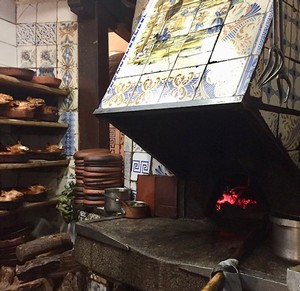
After dinner, we toured Botin's ancient wine cellar.
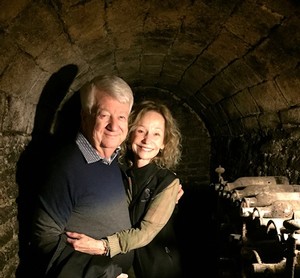
The next day, we visited Madrid's famous Plaza de Toros de Las Ventas, where its famous bull ring is situated and which dates back to 1929. The outdoor sculpture there depicts the bravura of the bullfighter.
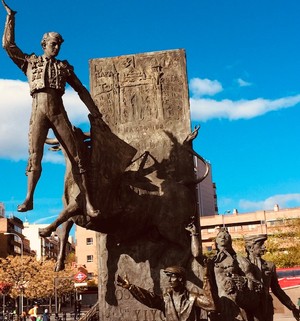
On our last night in Madrid, we and our friends were lucky to score the chef's kitchen table at the Michelin-starred A'Barra Restaurante for a 21st Century meal paired with both Spanish and French Wines, including Rioja and Bordeaux.
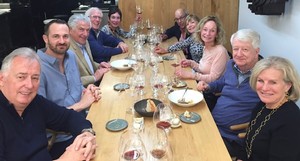
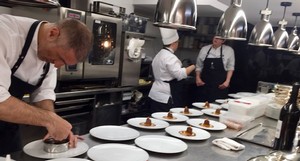
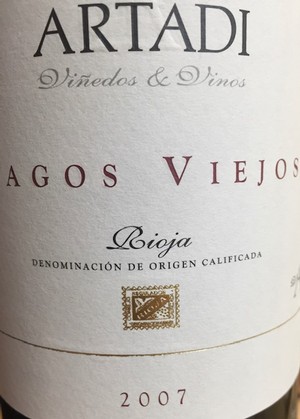
After our too-short, 3-day stay in Madrid, we boarded the ship on the Douro River on the Spanish border. The cruise was hosted by the Dry Creek Winegrowers Association of Sonoma. Some of our friends had signed up, so we said "all aboard!"
Ed and I had visited the Douro Valley before, but wanted to see its magnificant scenery again. Deep gorges alternate with tranquil valleys (mostly unpopulated, which we loved). Terraces on both sides of the river run down to rocky hillsides planted with vines.
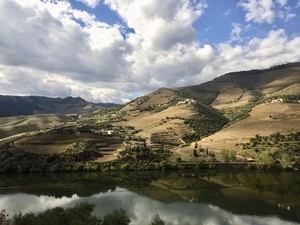
The Douro River rises in Northeastern Spain and flows in a westerly direction for 360 miles. For the next 70 miles it forms its border with Spain and then, for its only navigable stretch--the part which formed our cruise-- cuts across Portugal for 130 miles to reach the Atlantic at Porto.
The first morning of our cruise landed us in Pinhao, in the heart of the prime port-producing region. There we discovered the Pinhao railway station, with its series of 24 fine blue and white tile murals, illustrating the history of winemaking and the culture of the area.
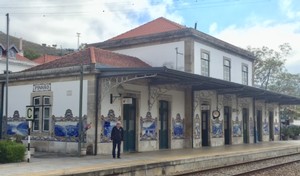
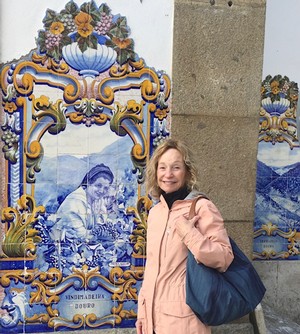
The train station, built in 1879, replaced the flat-bottomed boats that were previously used to carry wine in casks from quintas (wine-growing estates) downstream to Porto.
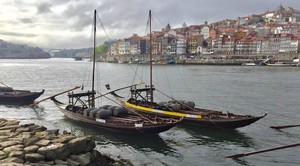
Now the wine is transported by tanker trucks.
During our cruise, we visited quintas for wine tasting, such as Quinta da Avessada, in the village of Favaios. There the "winegrower," with the nickname 'Mr. Bean" because of his resemblance to the actor, told us about the emphasis on preserving the unspoiled landscape of the Douro wine region.
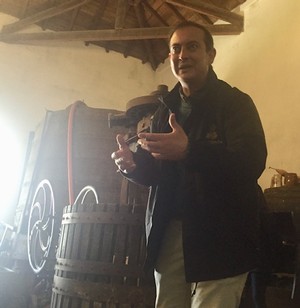
During another tasting, this time in Guimares, we sampled a very nice wine, new to us, called Vinho Verde. Although the name translates as green wine, it's usually drunk as a white wine. It's young, being released 3-6 months after harvest. It has a slight effervescence from the added carbonation.
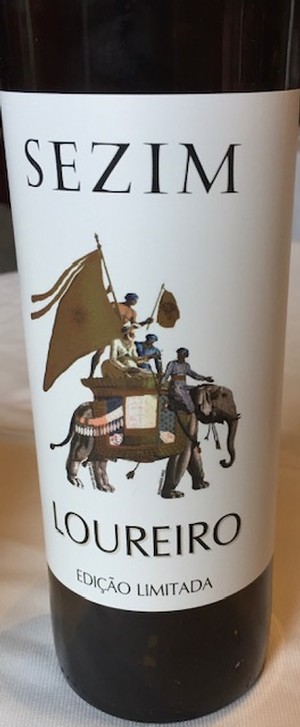
When Ed and I were much younger, we drank very inexpensive Mateus Rose wine out of round, squat bottles from Portugal. Who knew that the Mateus family owned an enchanting palace surrounded by extensive gardens, just outside of Vila Real, Portugal?
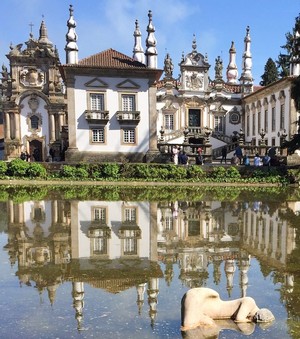
On our last day of cruising the Douro, we toured the city of Porto, the second largest city in Portugal, behind Lisbon. We took a cable car up a hill to Pont-Dom Luis, a bridge designed by a colleague of Gustav Eiffel in 1886. The bridge connects Porto to Vila Nova de Gaia, where port wine tasting rooms and storage facilities are located. From up there, we had dizzying views of the city below.
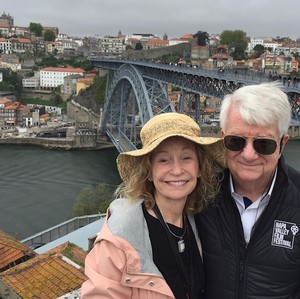
We are now ready for our next wine cruise of the Bordeaux wine region. 'Till then.............